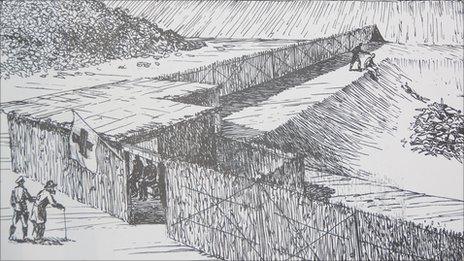Holocaust survivor preserves Treblinka in art
- Published

Israel is marking Holocaust Remembrance Day, commemorating the murder of six million Jews by the Nazis during World War II. Samuel Willenberg, who is now 87 years old, is one of the last two known survivors of the Treblinka extermination camp.
Treblinka was one of the most notorious Nazi death camps.
Part of the Nazis' "final solution", the camp in occupied Poland was dedicated to extermination, designed for efficient mass murder.
Between 1942 and 1943 around 870,000 Jews were killed there, according to Israel's Holocaust Memorial, Yad Vashem.
Not many of those who were sent to Treblinka lived to tell the tale.
Yad Vashem estimates that a few hundred people escaped from the camp, but only a few dozen of those survived the war.
Samuel Willenberg was one of the survivors. His two sisters were killed there.
Sitting in his flat in Tel Aviv, Mr Willenberg, who has written a book about his experiences, said he wanted to give testimony about "the tragedy that was Treblinka".
Most people were sent straight to the gas chambers, he said.
There was "no selection, no procedure, no special striped clothes like in Auschwitz".
"Here we wore the clothes that we found after people were sent to the gas chambers and that's all. It was death."
Memories of escape
But a chance encounter saved him from being killed on his first day in the camp.
He recognised one of the Jewish prisoners forced to work in the camp and asked him what he should do. "Say you are a builder, say you are a builder," the man told him.
As a result, Mr Willenberg said, he was "the only one that remained alive" from his transport.
"I was in shock. I couldn't believe what was happening before my eyes. It is difficult to grasp that suddenly people arrived and other people came and killed them by gas."
In the basement of his apartment building is a collection of bronze sculptures, created by Mr Willenberg to reflect his experiences in Treblinka and to preserve the memory of those who died.
One is of a girl with her head half-shaved. Another shows a father helping his son take off his shoes before being sent to the gas chamber.
On the wall are his drawings of the camp.
Mr Willenberg believes his sketch of the so-called Lazarett, or field hospital, where some prisoners were shot in the head, is the only eyewitness drawing to survive.
The Germans prevented anyone from making a record of it," he said.
Looking at his work, he paused in front of one group of figures representing the uprising in the camp against the Germans on 2 August 1943 - the day he escaped.
"Here I put the heroes of Treblinka," Mr Willenberg said.
Several of the figures brandished guns, but he sought out the one of a man lying on the ground, next to an overturned pram. He stroked it again and again.
"Alfred Boehm, my friend," he said.
"He helped me and took me out of the line that was taking us on to the gas. He fell in the uprising, he brought us guns and fell - and in his memory, I put him here.
Mr Willenberg was shot in the leg as he left the camp, climbing over the bodies of those who had already been gunned down.
"I ran straight ahead, alone. I wasn't afraid of being alone. The important thing was to escape."
He joined the Polish underground and fought against the Germans.
In 1950 he came to Israel.
Now he hopes his statues can one day be part of a museum at Treblinka.
The Holocaust casts a long shadow over Israel, which was founded three years after the end of World War II.
For survivors like Samuel Willenberg, the message is clear: never forget.
- Published6 April 2011
- Published27 January 2011
- Published27 January 2010